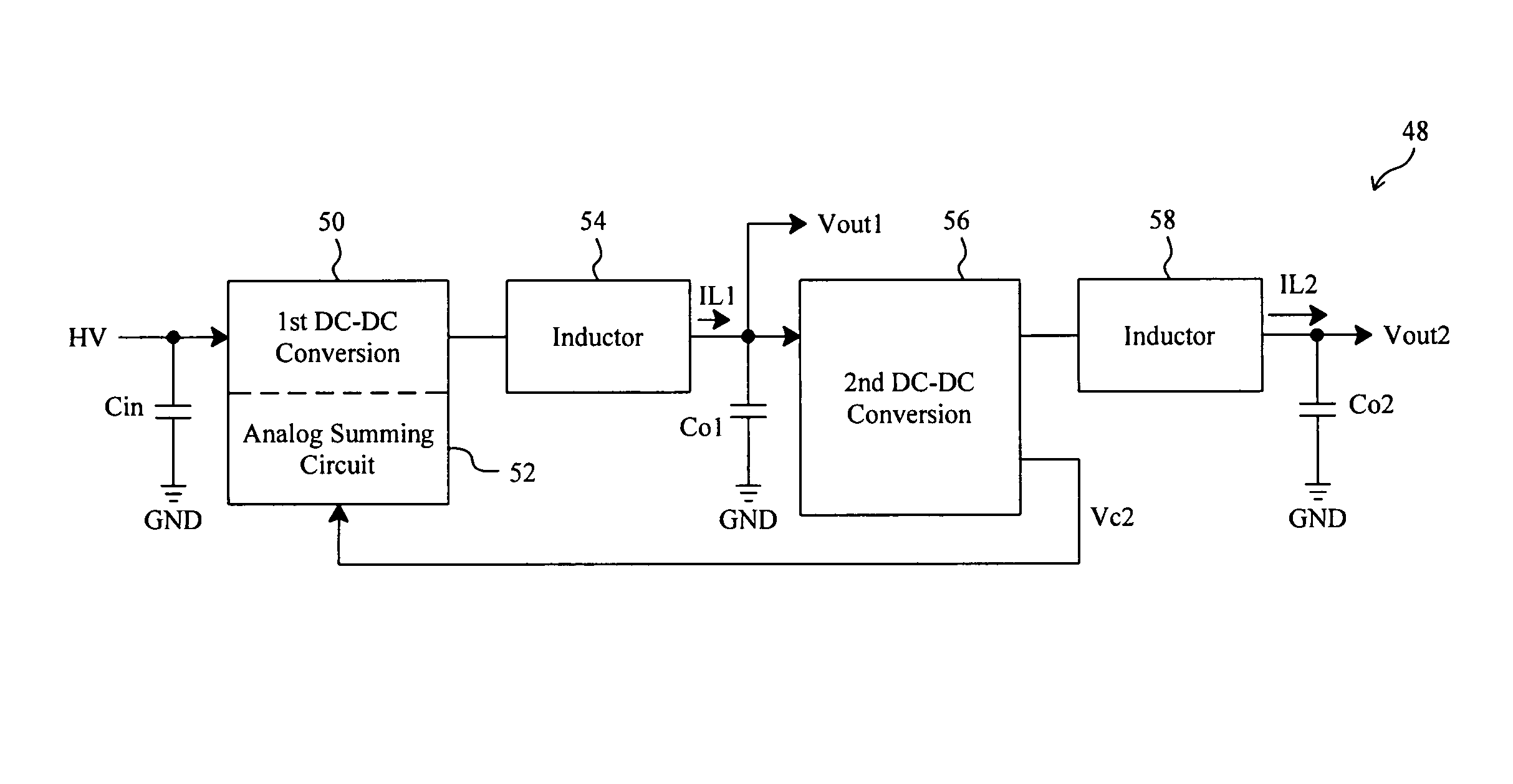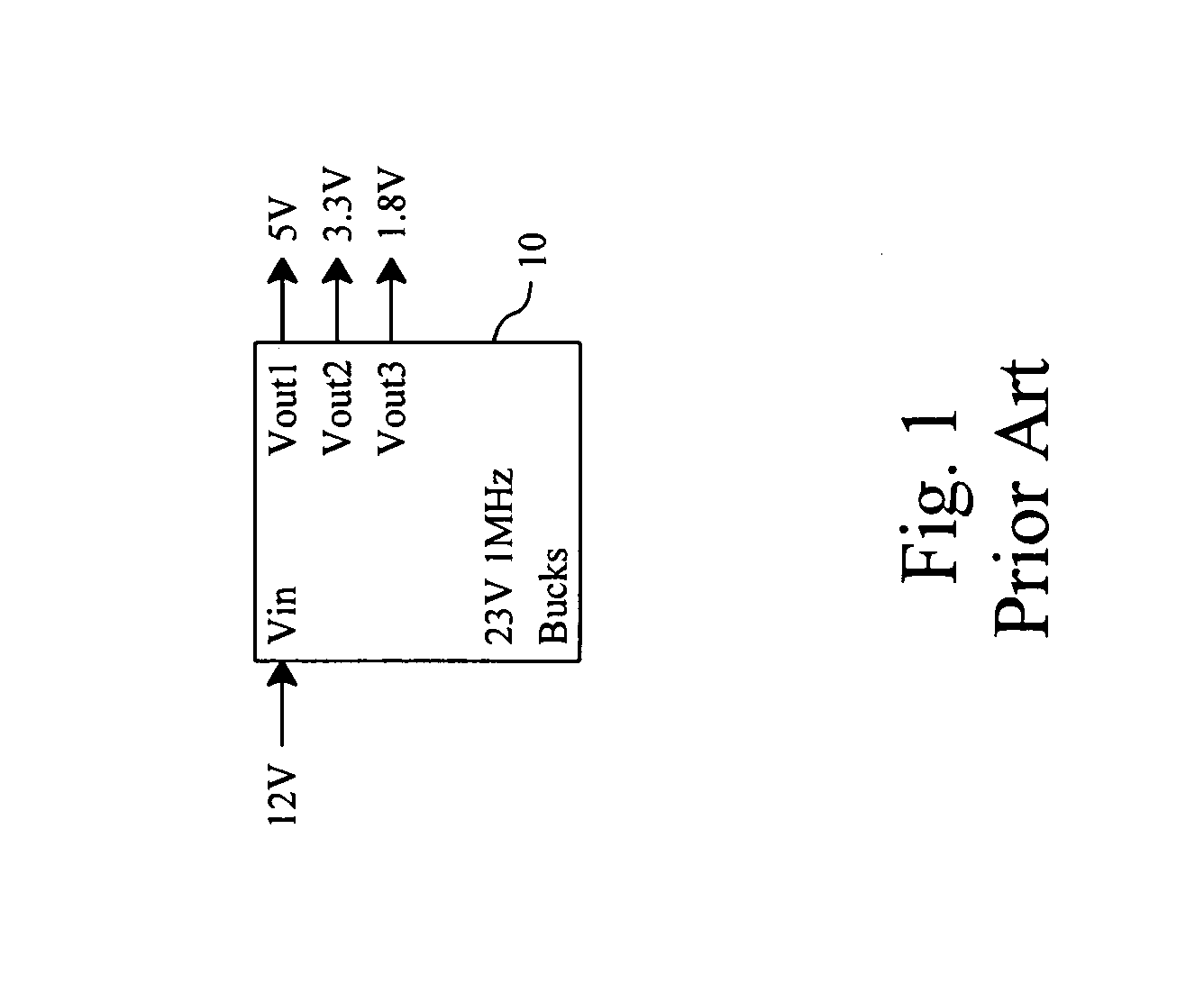Cross-interference reduction of a buck power converter
a cross-interference reduction and power converter technology, applied in the direction of electric variable regulation, process and machine control, instruments, etc., can solve problems such as not cost-efficien
- Summary
- Abstract
- Description
- Claims
- Application Information
AI Technical Summary
Benefits of technology
Problems solved by technology
Method used
Image
Examples
first embodiment
[0023] as shown in FIG. 6, a two-step power converter 48 includes two conversion stages. The first one includes a DC-DC conversion 50 and an inductor 54, and the second one includes a DC-DC conversion 56 and an inductor 58. The first conversion stage converts an input voltage HV to a first output voltage Vout1, and then the second conversion stage converts the first output voltage Vout1 to a second output voltage Vout2. Each of the DC-DC conversions 50 and 56 has one or more pairs of power switches. The DC-DC conversion 56 further includes a PWM control loop for stabling its output voltage Vout2. The PWM control loop for the DC-DC conversion 56 may also refer to FIG. 4. In this case, the error signal Vc2 generated by the PWM control loop for the DC-DC conversion 56 is fed forward to an analog summing circuit 52 of the DC-DC conversion 50, so as to stabilize the output voltage Vout1 of the first conversion stage when the output voltage Vout2 of the second conversion stage varies.
[002...
second embodiment
[0028]FIG. 11 is a circuit diagram of a second embodiment for the analog summing circuit 94 of FIG. 9, in which a PWM comparator 130 having multiple pairs of inputs is used in the PWM control loop of the first conversion stage to produce the PWM signal according to various signals. An error signal Vc1 is generated by an error amplifier 122 according to a reference voltage VREF1 and a feedback signal VFB1 that is derived from and thereby a function of the output voltage Vout1, and sent to a non-inverting input INP1 of the PWM comparator 130. A ramp signal 124 is sent to an inverting input INN1 of the PWM comparator 130. The error signal Vc2 extracted from the DC-DC conversion 96 passes through a high pass filter 126 along with any DC bias VB1 to generate signals Vc2′ and VB1′ (in fact, VB1′=VB1), which are sent to a non-inverting input INP2 and an inverting input INN2 of the PWM comparator 130 respectively. The error signal Vc3 extracted from the DC-DC conversion 98 passes through a ...
third embodiment
[0029]FIG. 12 is a circuit diagram of a third embodiment for the analog summing circuit 94 of FIG. 9, which also uses a PWM comparator 140 having multiple pairs of inputs in the PWM control loop of the first conversion stage for producing the PWM signal. An error signal Vc1 is generated by an error amplifier 132 according to a reference voltage VREF1 and a feedback signal VFB1 that is derived from and thereby a function of the output voltage Vout1, and then sent to a non-inverting input INP1 of the PWM comparator 140. A ramp signal 134 is sent to an inverting input INN1 of the PWM comparator 140. The error signal Vc2 extracted from the DC-DC conversion 96 is sent to a non-inverting input INP2 of the PWM comparator 140. The error signal Vc2 is also filtered by a low pass filter 136 to produce a signal Vc2′ sent to an inverting input INN2 of the PWM comparator 140. The error signal Vc3 extracted from the DC-DC conversion 98 is sent to a non-inverting input INP3 of the PWM comparator 1...
PUM
 Login to View More
Login to View More Abstract
Description
Claims
Application Information
 Login to View More
Login to View More - R&D
- Intellectual Property
- Life Sciences
- Materials
- Tech Scout
- Unparalleled Data Quality
- Higher Quality Content
- 60% Fewer Hallucinations
Browse by: Latest US Patents, China's latest patents, Technical Efficacy Thesaurus, Application Domain, Technology Topic, Popular Technical Reports.
© 2025 PatSnap. All rights reserved.Legal|Privacy policy|Modern Slavery Act Transparency Statement|Sitemap|About US| Contact US: help@patsnap.com



